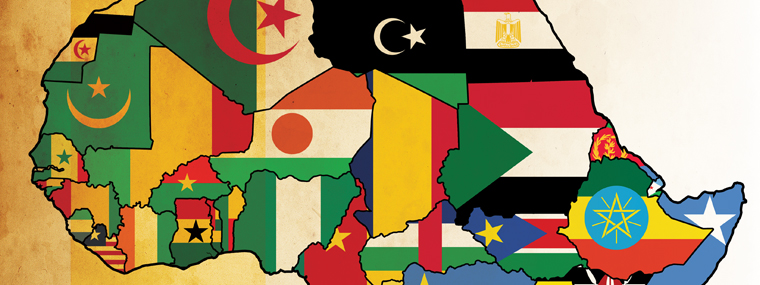
Growing Markets in Africa
By Diane M. Calabrese / Published October 2017

Land, or “terra,” is the (etymological) message bound up in the name of Africa, and rightly so. The immensity of the second-largest continent is striking in satellite images and on maps.
Bounded by the Atlantic Ocean, the Mediterranean Sea, the Red Sea, and the Indian Ocean, Africa has a large presence in both the northern and southern hemispheres. The Sahara Desert, the Nile River, and the rain-forested island nation of Madagascar are just a few of the rich landscapes across the continent.
There are 54 countries on the African continent. The most populated one is Nigeria (more than 191 million in 2017). In 2016, the population of the continent was more than 1.2 billion.
A vital and informative tool for anyone considering doing business—or doing more business—with countries on the African continent is the African Economic Outlook (AEO). AEO 2017 is the 16th edition, and like all previous editions it is freely available. (Visit www.africaneconomicoutlook.org.) The most recent edition focuses on entrepreneurship and industrialization.
The AEO reports derive from a partnership among the African Develop-ment Bank, the Organization for Economic Co-Operation and Development (head-quartered in Paris), and the United Nations Development Program.
Two highlights from the current AEO report illustrate the interest of Africans in fortifying their economies and communities: 80 percent of Africans view entrepreneurship as a good career path, and an economic growth rate of 3.4 percent is projected for the continent of Africa in 2017, while 4.3 percent is anticipated for 2018).
Emma Corder, marketing manager ZA (South Africa) with Nilfisk (Pty) Ltd, shares some of her insight into the pressure washer industry across Africa. Corder is based in Cape Town, South Africa. “Our company currently sells into 18 African countries, including South Africa, where we have a large sales and manufacturing entity,” says Corder. “In line with Nilfisk global Accelerate + strategy, Nilfisk South Africa is now responsible for North and sub-Saharan Africa, where we aim to realize large growth.”
Any company looking to serve customers across Africa must be dedicated to excellence. “The African environment is tough, and there is a large demand for high-performance, quality equipment,” says Corder.
The work being accomplished by pressure washers and ancillaries is as tough as it is significant. “With a large industrial and mining sector, high pressure machines are put through their paces with regards to performance and durability,” says Corder. “Often machines are placed on sites where limited access and infrastructure exist, which means servicing is often a challenge for the end user. Availability of technical support and spares is crucial.”
Aligning with entities who know a region well is a crucial strategy when entering or expanding markets across Africa. “Such vast differences exist between various countries and often between regions in the same country,” says Corder. “Having local partners to assist with cultural and economic challenges is key to growth.”
The rewards of serving customers in countries in Africa are great. Providing solutions to complex problems is one of the many rewards. “A large client in the food processing sector required a completely unique solution which involved a central line running through the plant with various high-pressure stations,” says Corder. “Multiple users meant a constant pressure was required through the system. Our company was able to customize a system resulting in a very happy customer.”
Serving customers across Africa challenges those in our industry (and other industries) to be nimble and creative. “Africa is a constantly evolving environment with massive potential for economic growth,” says Corder. “Being flexible enough to adapt with this evolution is key to achieving growth.”
Among the other pressure washer and pump manufacturers with a presence in Africa are Kärcher South Africa (Germiston, SA), Kränzle (Cape Town, SA), Hoffmann Power Products (Johannesburg, SA), Hawk Pumps (Durban, SA), CEMSA (Irene, SA) and PEMSA Technologies (Honeydew, SA).
Differences and Opportunities
Sources of foundational information about economic activity in each of the 54 countries in Africa are many and very good. The market overview series available at Export.gov is a great starting point for country profiles. The series derives from analyses prepared by U.S. embassies through the organizational efforts of the U.S. Commercial Service of the U.S. Department of Commerce.
Contrast some of what we learn from the Export.gov series regarding differences and similarities between Nigeria and South Africa. The population of South Africa is approximately 55.4 million, or only 29 percent as large as that of Nigeria.
The world’s largest producer of platinum, vanadium, chromium, and manganese, South Africa also has the most diversified and advanced economy in Africa. Primary economic sectors are agriculture, fishing, and mining, which account for 10 percent. Secondary economic sectors are manufacturing, construction, and utilities, which account for 21 percent. Like the United States, services account for the most economic activity, or 69 percent.
In two-way trade, the United States is the third largest trading partner of South Africa. Among the plusses the Export.gov report tallies for U.S. companies doing business with South Africa are a friendly business environment, non-arduous (“benign”) legal processes, and ties to other countries on the African continent that could smooth expansion of exports.
Nigeria has suffered economically in recent years because of decline in the global price of oil. The country is the largest oil producer in Africa, and oil has accounted for as much as 90 percent of Nigeria’s export revenues.
The population of Nigeria is very young, with almost two-thirds under age 25. Nearly two-thirds of the population live in poverty. The Export.gov report on Nigeria characterizes the regulatory environment in the nation as “chaotic” and cites the need for willingness to maneuver through much complexity in order to do business. Yet with Nigeria aiming to improve infrastructure and agriculture, there are many opportunities to do business.
A bilateral trade and investment agreement exists between the United States and Nigeria. Even so, the Export.gov report is less than sanguine about immediate opportunities in Nigeria. There are many future possibilities, however, as logistics and infrastructure improve. For example, with a great amount of arable land, Nigeria produces nuts, fruits, and grains, but it does so largely through subsistence farming. As approaches in agriculture and transportation modernize, opportunities will multiply for all business sectors.
Resources, Parameters
In addition to the aforementioned AEO and Export.gov reports, which are superb resources for immersion in business prospects and constraints in countries across Africa, another pertinent resource is Trade.gov, an online resource for data managed by the International Trade Administration (ITA) of the U.S. Department of Commerce.
Some ITA data on Africa may be surprising. For example, the economic activity of sub-Saharan Africa puts the region among places with the highest GDP growth in the world. Since 2010, the region has exhibited growth near or above five percent annually.
In addition, U.S. exports to sub-Saharan countries have increased by about 11.3 percent annually (i.e., year over year) since 2000. (The U.S. trade deficit with the region is still negative but shrinking.)
More than 30,000 U.S. companies export to Africa. More than 90 percent of the companies are small- and medium-sized businesses (SMEs by U.S. Small Business Administration characterization.) Twice as many of the exports go to countries in sub-Saharan Africa as to North Africa, but trade with North Africa is also on a trajectory of year-over-year increase.
The parameters that limit business efforts in Africa are well known and require redress. As the AEO 2017 notes, investment is needed not only in agriculture, infrastructure, and so on, but also in human welfare—in particular, health education and skills of the people of Africa, more than half of whom live in poverty.
In fact, the easy overlap of needs and basic services that defines developed countries is still being tied together in many countries in Africa. The ITA gives the example of the cold chain.
As many of our readers who serve the food industry know, a cold chain is a seamless system of cold storage linking farmers to consumers. Trucks, distribution centers, and markets are all equipped to prevent food from perishing too quickly. As ITA reminds readers, a cold chain also supports pharmaceutical and other products, enabling them to retain their integrity for an extended period.
Working out of Kenya as a start, the Global Cold Chain Alliance (GCCA), the ITA, and others began in late 2015 to develop cold chains for Kenya and other countries in East Africa. (Kenya has the largest economy in East Africa.)
At this point in time, the pressure washers for fleet washing in Africa may not find huge demand. But as cold chains and all other parts of infra-structure develop, that will change.
For now, cleaning equipment and pumps required for mining and oil production, or the industrial niche, will continue to see the greatest demand. Commercial enterprises—from real estate to retail—are still developing. As the economies of countries in Africa gain strength and diversify, the markets for cleaning equipment, wastewater treatment, and all ancillaries to pressure washers will expand.





